|
|
Mortality Rate Deaths/1000 Births |
Mortality Rate Deaths/100,000 Births |
|
| |
||
| |
||
| |
||
| |
||
| |
||
| |
||
| |
14 September 2004 More than 80% of Cambodia's people are farmers, and 85% of the farmers still use cattle for plowing. A pair of oxen like these costs more than US $1,500! That's three years wages for a factory worker.
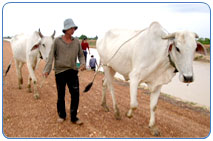
30 April 2004 The Mekong River is at its lowest level in ten years, and the lack of rain north of Phnom Penh--in northern Cambodia, Laos, and China--is starting to affect our electricity supply. There isn't enough water going through the hydroelectric generating stations in the northeast of the country, so "rolling blackouts" are being staged, cutting power to selected areas for a short while so that other areas can maintain full power. Last night our power went off at 3:00 AM. It probably wasn't an intentional blackout--we have enough unintentional ones, too!--because only a small area was affected. It sure got hot in my room, though, without the fans--93º with no air moving. Definitely uncomfortable.
23 April 2004
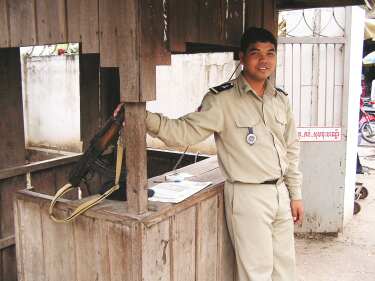 Cambodia, and especially Phnom Penh, the big city, has lots of crime. Still I don't know if I feel any safer with this guard at the Disability Action Council where I work in addition to our office at the Deaf Development Program. He leaves his AK-47 propped up against the post of the little guardhouse where he spends the day. I've wondered if he actually has any ammunition for it.
Cambodia, and especially Phnom Penh, the big city, has lots of crime. Still I don't know if I feel any safer with this guard at the Disability Action Council where I work in addition to our office at the Deaf Development Program. He leaves his AK-47 propped up against the post of the little guardhouse where he spends the day. I've wondered if he actually has any ammunition for it.
21 April 2004 Cambodia surpasses almost all other countries of the world in the amount of vitamin deficiency here. Households here are less likely to use iodized salt than households in Afghanistan. More Cambodian women are anemic than in neighboring Vietnam or Laos. Children here suffer more from vitamin A deficiency than in Mongolia or Mozambique. The available supplements are relatively inexpensive, according to health officials. But distribution problems, cultural attitudes toward food, and lack of enthusiasm among the donor community have hampered remedial measures.
20 April 2004
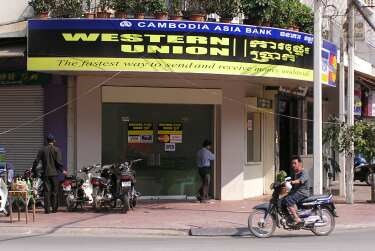 I'm not at all sure why it is happening, but in the last six months probably a dozen Western Union outlets have opened up in the city of Phnom Penh. Previously there was one Western Union place on the Naga gambling boat anchored in the Mekong River, but now they have sprouted throughout the city. What does that indicate? Are relatives who have emigrated sending money back? Surely people here aren't sending much money abroad. And why the sudden increase in the Western Union service?
I'm not at all sure why it is happening, but in the last six months probably a dozen Western Union outlets have opened up in the city of Phnom Penh. Previously there was one Western Union place on the Naga gambling boat anchored in the Mekong River, but now they have sprouted throughout the city. What does that indicate? Are relatives who have emigrated sending money back? Surely people here aren't sending much money abroad. And why the sudden increase in the Western Union service?
6 April 2004 The World Health Organization yesterday released figures on traffic-related fatalities and injuries, and the news for Asia is certainly grim. Asia has 16% of the world's vehicles but accounts for 60% of global road deaths. Asian road fatalities rose 40% between 1987 and 1995. WHO estimates that at current rates, by the year 2020 road accidents will be the third leading cause of death after heart disease and depression. In Cambodia, 824 people died in road accidents last year, and the rate has been going up 30% a year. Part of the rise is due to the surfacing of roads which increases the speed of vehicles, and also a recent survey of 50,000 motorbike riders found that only 8% wore helmets.
17 March 2004
 Bicycles, cyclos (three-wheeled double-seat bicycles), and motorbikes--all the normal vehicles in traffic in Phnom Penh. One encouraging development is that more people are wearing helmets today than would have just a few years ago. That's probably because almost everyone knows someone who suffered death or severe head injuries in helmet-less crashes. One atypical aspect of this photo is that all the vehicles are going the right direction on their side of the road. Usually traffic moves in both directions in both lanes, just weaving in and out and around to avoid head-on collisions.
Bicycles, cyclos (three-wheeled double-seat bicycles), and motorbikes--all the normal vehicles in traffic in Phnom Penh. One encouraging development is that more people are wearing helmets today than would have just a few years ago. That's probably because almost everyone knows someone who suffered death or severe head injuries in helmet-less crashes. One atypical aspect of this photo is that all the vehicles are going the right direction on their side of the road. Usually traffic moves in both directions in both lanes, just weaving in and out and around to avoid head-on collisions.
14 March 2004
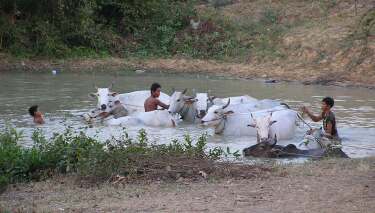 A ritual repeated all over the world--wherever there are cattle and water--is the evening leading of the cattle to the pond or stream to drink and wash off the day's dust and ever-present bugs. Here boys near the Killing Field at Phnom Penh tend to their cattle before taking them home for the night. This breed is especially common in Cambodia although I cannot find anyone who can give me the official name of the breed.
A ritual repeated all over the world--wherever there are cattle and water--is the evening leading of the cattle to the pond or stream to drink and wash off the day's dust and ever-present bugs. Here boys near the Killing Field at Phnom Penh tend to their cattle before taking them home for the night. This breed is especially common in Cambodia although I cannot find anyone who can give me the official name of the breed.
11 March 2004
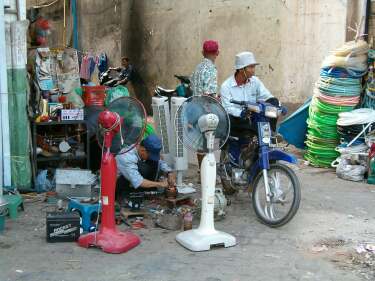 Certain types of stores tend to be clustered in different parts of the city of Phnom Penh. Shops selling fans and lights and electrical fixtures take up most of several blocks on Monivong Boulevard, a major north-south street. Often the occupants and merchandise spill out on to the sidewalk. The area in front of the store pictured has been turned into the repair area, this man spending his days repairing fans and electric motors for resale. The man on the motorbike is a mototaxi driver called a motordupe. He's keeping an eye out for a fare.
Certain types of stores tend to be clustered in different parts of the city of Phnom Penh. Shops selling fans and lights and electrical fixtures take up most of several blocks on Monivong Boulevard, a major north-south street. Often the occupants and merchandise spill out on to the sidewalk. The area in front of the store pictured has been turned into the repair area, this man spending his days repairing fans and electric motors for resale. The man on the motorbike is a mototaxi driver called a motordupe. He's keeping an eye out for a fare.
4 March 2004 Mom, dad, and two kids set out on a trip on the family motorbike. Safety is not much of a consideration. Luckily the slow speeds of traffic in the city--partly due to the congestion, partly to the poor condition of the roads--keeps more people from being killed although quite enough are injured daily.
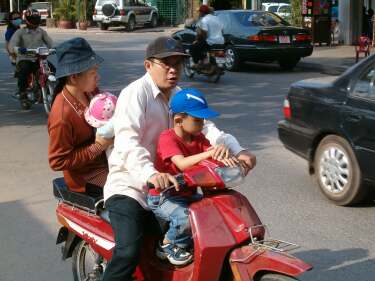
1 March 2004
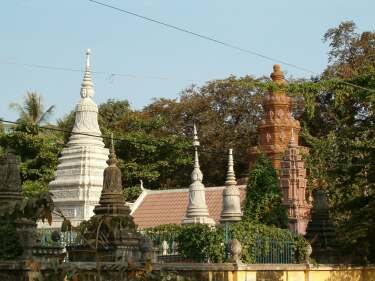 Almost every wat (Buddhist temple)has anywhere from one or two to dozens of small mausoleum stupas arrayed around the central temple. They are the burial places of the ashes of former revered monks, especially the abbots who led a monastery, sometimes for many years. After death, their bodies are cremated and then their ashes are preserved in small stupas like the ones whose towers you see in this photograph in a wat near the Royal Palace in Phnom Penh. The different sizes and decorations of a memorial stupa are indications of the monk's status and the reverence afforded him in life.
Almost every wat (Buddhist temple)has anywhere from one or two to dozens of small mausoleum stupas arrayed around the central temple. They are the burial places of the ashes of former revered monks, especially the abbots who led a monastery, sometimes for many years. After death, their bodies are cremated and then their ashes are preserved in small stupas like the ones whose towers you see in this photograph in a wat near the Royal Palace in Phnom Penh. The different sizes and decorations of a memorial stupa are indications of the monk's status and the reverence afforded him in life.
29 February 2004
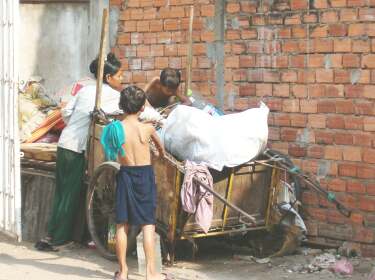 Many people in Cambodia, especially in the cities, make a living from garbage and discarded items. This mother is checking her cart in the yard of a Buddhist wat (temple) which she and her sons probably call home. The older boy has just lugged a large plastic bottle of water to the cart for them to drink while they are covering the streets, calling out "Ay-jai" ("discarded things") to ask people to give or sell them things they can then resell for a little profit.
Many people in Cambodia, especially in the cities, make a living from garbage and discarded items. This mother is checking her cart in the yard of a Buddhist wat (temple) which she and her sons probably call home. The older boy has just lugged a large plastic bottle of water to the cart for them to drink while they are covering the streets, calling out "Ay-jai" ("discarded things") to ask people to give or sell them things they can then resell for a little profit.
13 February 2004 Last September I wrote about the Internet coming to remote areas of Cambodia. Read more about the project in an article from the New York Times, with pictures.
8 February 2004 Going to the hospital in Cambodia is difficult. This pictures shows a man and his family in the infectious diseases ward of the Preah Sihanouk Hospital, more commonly known as the Russian Hospital because the USSR built it in the days when Cambodia received help only from the Eastern Bloc. Why is a hospital stay in Cambodia difficult?
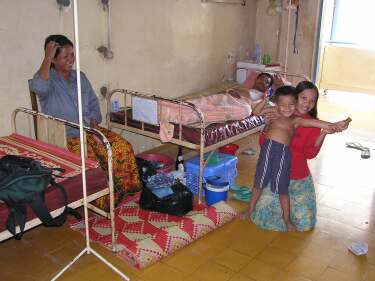
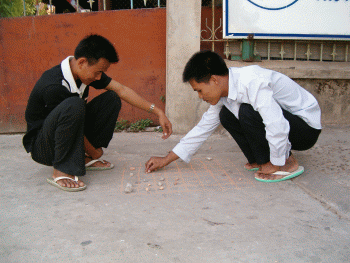 Most Khmer people have little formal education, and the formal education that some have is often not high-quality, but there is a strong fascination with the game of chess in Cambodia. It is not unusual at all to see two people hunched over a chess "board" drawn on the pavement, with rocks or bottle caps for the chess pieces, and lots of interested kibitzers overseeing the game.
Most Khmer people have little formal education, and the formal education that some have is often not high-quality, but there is a strong fascination with the game of chess in Cambodia. It is not unusual at all to see two people hunched over a chess "board" drawn on the pavement, with rocks or bottle caps for the chess pieces, and lots of interested kibitzers overseeing the game.
 A teacher helps one of the pupils in her non-formal education class held in the home of a village family. Maryknoll has a project in the Boeung Tum Pun area of Phnom Penh that has no schools but has lots of kids who want to study. Sr. Regina Pellicore offers special classes to help students who have never been to school to catch up to their grade level.
A teacher helps one of the pupils in her non-formal education class held in the home of a village family. Maryknoll has a project in the Boeung Tum Pun area of Phnom Penh that has no schools but has lots of kids who want to study. Sr. Regina Pellicore offers special classes to help students who have never been to school to catch up to their grade level.